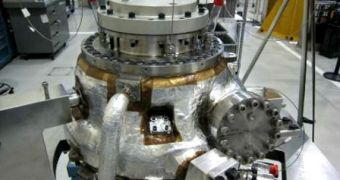Officials at the NASA John C. Stennis Space Center (SSC), in Hancock County, Mississippi, say that their installation has just completed a new series of tests on the next-generation J-2X upper-stage engine that the American space agency will use on upcoming delivery systems.
The motor is being developed by engineers at Pratt & Whitney Rocketdyne, who have been working on it for quite some time now. The company is also responsible for producing the engines that have been driving the space shuttles for more than 30 years.
Now, the corporation is getting ready to take the lead in space exploration technologies yet again, with the J-2X. While the exact design of the NASA rocket that will carry these engines is not yet known, experts say that there shouldn't be any problem with fitting the components on any rocket.
Once in orbit, the new motor can provide an estimated 294,000 pounds of thrust, which is achieved by changing the ratio of the liquid oxygen-liquid hydrogen fuel mixture it uses. This is enough to take spacecraft or rocket stages off low-Earth orbit, and put them on another trajectory.
By using the J-2X, it could be possible to aim future vehicles or payloads to the Moon, Mars, or even near-Earth objects (NEO). US President Barack Obama's space policy calls for NASA to reach a NEO by 2025, and Mars by the 2030s.
“The successful start of J-2X engine testing demonstrates Pratt & Whitney Rocketdyne is ready to be a part of the next generation of future space solutions, including a heavy-lift launch vehicle as well as commercial space options,” explains Walt Janowski.
“Having a plan now for future space needs is paramount to our national security, our industrial base and our nation's ability to continue accessing and exploring space without being dependent on foreign providers,” adds the official.
He is both the director and the manager of the J-2X Engine Program at Canoga Park, California-based Pratt & Whitney Rocketdyne. The expert explains that the engines are designed specifically for heavy-lift rockets.
J-2X is powered by a mixture of liquid hydrogen and liquid oxygen. This approach is extremely efficient for providing massive thrust. Experts at Pratt &Whitney are convinced that the motor will behave admirably, if it enters production.
Congress is still deliberating on the budget NASA will receive for 2012, and the fate of the J-2X and other programs is entirely dependent on that, SpaceRef reports.

 14 DAY TRIAL //
14 DAY TRIAL //